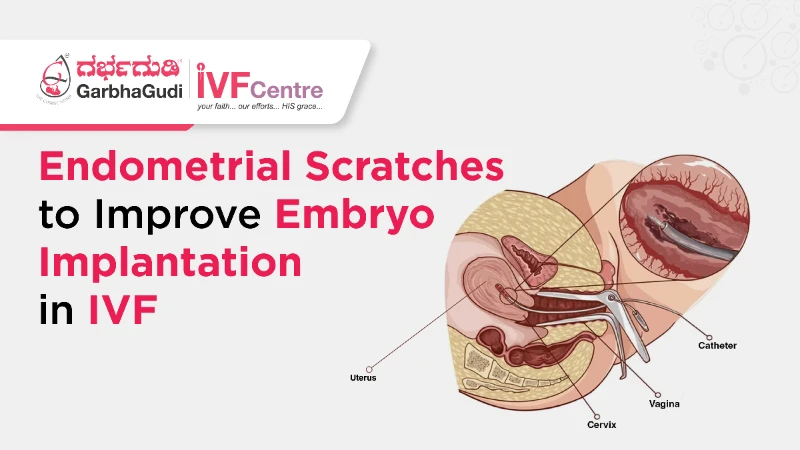Does Endometrial Scratching Improve IVF Implantation?

Endometrial scratching is an increasingly discussed technique in fertility treatments, particularly for individuals undergoing in-vitro fertilization (IVF). This procedure involves creating a small, controlled injury in the lining of the uterus (endometrium) using a catheter or other medical instruments. The theory behind endometrial scratching is that the minor injury triggers a healing response, releasing growth factors and cytokines that improve the endometrium’s receptivity to an embryo, thereby increasing the chances of successful implantation. While the procedure has shown promise, it remains a subject of debate among fertility specialists.
What Is Endometrial Scratching?
Endometrial scratching is a simple, minimally invasive procedure usually performed during the luteal phase (second half) of the menstrual cycle or in the cycle preceding an embryo transfer. During the procedure:
A small catheter or biopsy instrument is inserted into the uterus via the cervix.
The device is used to gently scratch or "injure" the endometrial lining.
This controlled injury is believed to induce a localized immune response, promoting the release of substances that enhance implantation.
How Does Endometrial Scratching Work?
The success of embryo implantation depends on two key factors: embryo quality and uterine receptivity. Endometrial scratching specifically targets uterine receptivity by altering the local environment of the endometrium.
1. Triggering a Healing Response:
The controlled injury stimulates the release of growth factors, cytokines, and hormones that repair the endometrium and enhance its ability to support embryo implantation.
2. Modulating Immune Activity:
The procedure alters the immune environment of the uterus, potentially increasing the levels of white blood cells and other immune cells that support implantation.
3. Synchronizing Implantation Windows:
Some studies suggest that endometrial scratching may improve the timing of the "implantation window," the period when the uterus is most receptive to an embryo.
When Is Endometrial Scratching Recommended?
Endometrial scratching is not a standard procedure for all fertility patients. It is typically recommended in specific scenarios:
Recurrent Implantation Failure (RIF):
For individuals who have undergone multiple unsuccessful embryo transfers despite good-quality embryos.
Unexplained Infertility:
In cases where the cause of infertility is unknown, endometrial scratching may be considered as part of the treatment strategy.
Frozen Embryo Transfers (FET):
Some specialists use endometrial scratching before frozen embryo transfer cycles to optimize uterine receptivity.
Prior to IVF Treatment:
For patients with a history of failed IVF cycles, endometrial scratching may be performed in the cycle preceding embryo transfer to improve outcomes.
Does Endometrial Scratching Improve Implantation?
The effectiveness of endometrial scratching is a subject of ongoing research, with studies yielding mixed results:
Positive Evidence:
Some studies suggest that endometrial scratching improves implantation rates, particularly in individuals with recurrent implantation failure.
A systematic review indicated that individuals undergoing endometrial scratching before IVF had higher pregnancy and live birth rates compared to those who did not.
Neutral or Negative Evidence:
Other studies have found no significant benefit of endometrial scratching in improving implantation or pregnancy rates, particularly in individuals with no history of implantation failure.
Some researchers argue that the benefits observed in certain cases may be due to placebo effects or the psychological reassurance provided by trying an additional intervention.
Advantages of Endometrial Scratching
Non-Invasive and Low-Risk:
The procedure is minimally invasive and can often be performed in a fertility clinic without anesthesia.
Cost-Effective:
Compared to other fertility treatments, endometrial scratching is relatively inexpensive.
Potential to Enhance Uterine Receptivity:
For individuals with recurrent implantation failure, the procedure may provide an additional boost to implantation success.
Customizable Timing:
The procedure can be easily scheduled within the natural or stimulated menstrual cycle.
Disadvantages and Risks of Endometrial Scratching
Discomfort and Pain:
Some patients experience cramping or mild pain during or after the procedure.
Mixed Efficacy:
The scientific evidence supporting endometrial scratching is inconclusive, and its benefits may vary between individuals.
Potential for Infection:
Although rare, there is a small risk of uterine infection or endometrial damage.
Timing Challenges:
The procedure must be carefully timed within the menstrual cycle to align with the implantation window.
Emotional and Financial Considerations:
For patients undergoing multiple fertility treatments, adding another procedure can increase emotional and financial burdens.
Who Should Avoid Endometrial Scratching?
Endometrial scratching may not be suitable for everyone, including:
Individuals with active uterine infections or inflammatory conditions.
Patients who are sensitive to pain or discomfort during pelvic procedures.
Those who have not experienced implantation failure or have no specific reason to suspect poor uterine receptivity.
How Is Endometrial Scratching Integrated with IVF?
Endometrial scratching is typically performed in the menstrual cycle prior to an embryo transfer cycle. The timeline usually involves:
Performing the procedure during the luteal phase (7-10 days after ovulation) or early in the menstrual cycle.
Allowing the endometrium to heal and prepare for implantation in the subsequent cycle.
Proceeding with the embryo transfer after confirming the uterine lining's readiness.
Future Directions in Endometrial Research
As the field of reproductive medicine evolves, researchers are exploring ways to refine and optimize endometrial scratching:
Biomarker Identification:
Identifying biomarkers of uterine receptivity may help determine which patients are most likely to benefit from the procedure.
Improved Techniques:
Developing less invasive or automated methods for endometrial stimulation could reduce discomfort and risks.
Combination Therapies:
Combining endometrial scratching with other treatments, such as growth factor infusions, may further enhance outcomes.
Large-Scale Clinical Trials:
More comprehensive trials are needed to confirm the efficacy and safety of endometrial scratching across diverse patient populations.
Endometrial scratching is a promising yet controversial technique in fertility medicine. By stimulating the uterine lining and enhancing its receptivity, the procedure has the potential to improve implantation rates, particularly for individuals with recurrent implantation failure. However, its effectiveness remains inconsistent, and further research is needed to identify the patients who would benefit the most.
While endometrial scratching is generally safe, patients should discuss its potential benefits and risks with their fertility specialist to make an informed decision. As the science of implantation continues to advance, endometrial scratching may serve as one piece of the puzzle in optimizing fertility outcomes and helping more individuals achieve their parenthood goals.